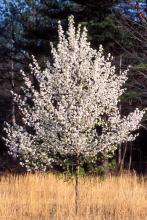Trees, Shrubs and Woody Vines
Media

Species Types
Scientific Name
Rosa multiflora
Description
Starting more than a century ago, this nonnative rose was planted across America — for many good reasons — but multiflora rose has proven to be invasive, and now the goal is to stop its spread.
Media

Species Types
Scientific Name
Quercus spp.
Description
Oaks are the most important group of trees in Missouri, in both human and ecosystem value. They dominate most of the forests, woodlands, and savannas in the state. Learn more about our 22 species.
Media

Species Types
Scientific Name
Symphoricarpos orbiculatus
Description
Buckbrush, or coralberry, grows throughout Missouri. This familiar thicket-forming shrub bears dense clusters of pinkish-red berries that persist through most of the winter.
Media

Species Types
Scientific Name
Various species in the genus Crataegus
Description
Our state flower, the hawthorn, is solidly represented in Missouri. There are about 100 different kinds of hawthorns that occupy almost every kind of soil in every part of the state. These members of the rose family are closely related to apples.
Media

Species Types
Scientific Name
Ilex decidua
Description
Possum haw, or deciduous holly, is the more common of two native Missouri hollies that lose their leaves each fall. This shrub or small tree is eye-catching in the fall and winter with its bright red berries.
Media

Species Types
Scientific Name
Pyrus calleryana
Description
'Bradford', a type of Callery pear, has been hugely popular in landscaping, but it can escape and hybridize with relatives. Alarmingly, it has become an invasive plant. Learn more about this problem tree.
Media

Species Types
Scientific Name
Salix spp. (about 12 species in Missouri)
Description
Exotic willows are available at lawn and garden centers, but there are several willow species that are native to Missouri. Most are rather humble colonizers of gravel bars, riverbanks, and lakesides. Many are important for human economic interests. All have a place in our wild ecosystems.
Media

Species Types
Scientific Name
Corylus americana
Description
American hazelnut is a thicket-forming shrub that grows to about 10 feet high. It is prized for its edible nuts, which are covered by a distinctive leafy or papery, jagged-edged bract.
Media

Species Types
Scientific Name
Quercus palustris
Description
Pin oak is one of the easiest trees to recognize by its shape alone: It has a tall, straight trunk, an overall pyramidal or conical shape and, most notably, the branches on the lower third of the tree angle downward.
Media

Species Types
Scientific Name
Toxicodendron radicans
Description
Poison ivy is a toxic plant that contains an oil in all its parts that, if you come into contact with it, can cause an intense skin reaction. Learn to recognize it, and sidestep it on your outings.
See Also
About Trees, Shrubs and Woody Vines in Missouri
There are no sharp dividing lines between trees, shrubs, and woody vines, or even between woody and nonwoody plants. “Wood” is a type of tissue made of cellulose and lignin that many plants develop as they mature — whether they are “woody” or not. Trees are woody plants over 13 feet tall with a single trunk. Shrubs are less than 13 feet tall, with multiple stems. Vines require support or else sprawl over the ground.





















